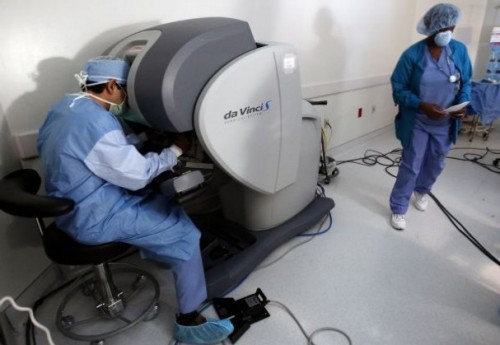Source: www.commercialappeal.com
Author: Tom Charlier
The cancer in James Entrekin’s throat has curdled around the base of his tonsils, way too far down for a traditional surgeon to reach without doing a lot of cutting and bone-breaking. But there’s nothing traditional about the surgery going on in this Methodist University Hospital operating room. Employing nimble, cable-thin arms, a robot reaches into Entrekin’s mouth while wielding four instruments at once — removing tumors, cauterizing vessels, suctioning fluids and transmitting three-dimensional video images of the whole thing.

Dr. Sandeep Samant buries his head in the da Vinci Surgical System while performing a robotic throat surgery at Methodist University Hospital.
In a couple of hours, it’s over. And since there was no need to cut open his face and throat and break his jaw, as is done in conventional oral-cancer surgeries, Entrekin will enjoy a lower risk of complications and a much shorter recovery period, while avoiding extended difficulties swallowing and speaking.
“You avoid all that because that natural anatomy is not violated,” says Dr. Sandeep Samant, who guided the robot from a console in a corner of the operating room.
Although there are many types of surgeries where they can’t be used, robots such as the nearly $2 million device used in Entrekin’s case are carrying an ever-growing workload in the operating rooms of Memphis hospitals. Less than a decade after robotic surgery was introduced in Memphis, there now are five robots — one each in Methodist University, Methodist North and Methodist Germantown and two at Baptist Memorial Hospital-Memphis — performing roughly 1,000 operations annually.
They’re doing hysterectomies, removing prostates and kidneys, replacing heart valves, cutting out cancerous lung lobes and, beginning about year ago, conducting head and neck surgeries such as Entrekin’s. Comparative figures are difficult to come by, but in the Methodist Le Bonheur system alone the number of robotic surgeries increased 40 percent, to 491, last year as the third robot was added. At Baptist, robotic surgeries have become increasingly commonplace and now number 500-550 annually, said Dana Dye, chief nursing officer.
For all their current popularity, robots weren’t readily accepted by everyone in the medical community, said Dr. Todd Tillmanns, president of the Memphis Robotic Surgical Society. Not only did the robots represent a new technology, but they were somewhat difficult for doctors to master at first.
“Learning it … takes an investment in time,” said Tillmanns, a gynecologic oncologist.
But as surgeons became proficient, they couldn’t help but be impressed by the advantages robotic surgery offer patients, he said.
“It’s a minimal-access surgery. You have smaller incisions, more delicate surgeries, less blood loss, less injury to localized tissue, and because of that, the patient recovers faster and has much less pain,” Tillmanns said.
In robotic gynecologic surgeries, he said, about 95 percent of patients leave the hospital less than a day afterwards — compared to a norm of three or four days for traditional operations. Within three days, 75 percent of the patients are not taking any pain medication, and they generally return to normal routines within three to seven days. As for cost, robotic surgery is less expensive than conventional “open” surgery but a little more costly than laparoscopic procedures, Tillmanns said.
The head and neck surgery now done at Methodist University represents the newest wave in the technology. The hospital is one of a small number across the nation where it is available, said Samant, who is professor and head of the division of head and neck surgery at the University of Tennessee Health Science Center. As with other robotic surgeries, the operations are directed by surgeons manipulating hand and foot controls at a nearby console.
Samant, with his head pressed against a console and his hands gripping a controller, looks as if he could be directing ninja cyborgs or repelling an alien invasion in a video game. Actually, he’s seeing a close-up, 3-D image of Entrekin’s throat.
“When you’re looking at it, you almost want to reach out and operate with your hands,” he said later.
The movements of Samant’s hands are transmitted to the robot’s arms, which have all the maneuverability of human wrists. In addition to having smaller limbs capable of reaching places human hands can’t, the robot can filter out tremors for smoother, less error-prone movements than human limbs are capable of.
The patient, Entrekin, is a 56-year-old Air Force retiree and laid-off truck driver who, after noticing a lump on his neck, was diagnosed with advanced cancer of the tonsils and base of tongue. He never smoked and previously had been hospitalized only once.
Entrekin, who has lived in Memphis for about 10 years, said he researched his options and was drawn to the benefits offered by robots. He said that if the only surgical option had been the traditional kind — requiring his jaw to be broken and lower face and throat cut open — he probably would have opted for just chemotherapy and radiation.
“That’s just so invasive, drastic,” Entrekin said.
Although he experienced some minor complications, Entrekin said he’s been pain-free since the operation and feels energetic and vital. He starts radiation in April and says he’s been given a good prognosis. Entrekin also said he wasn’t too nervous about the prospect of having a robot reach down his throat.
“I was less nervous (about that) than having my jaw cut open.”

Leave A Comment
You must be logged in to post a comment.